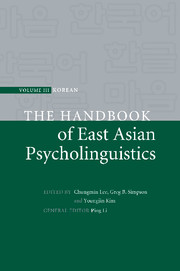Book contents
- Frontmatter
- Contents
- List of figures
- List of tables
- List of contributors
- Preface
- Introduction: Advances in Korean psycholinguistics
- Part I Language acquisition
- 1 Acquisition of the subject and topic nominals and markers in the spontaneous speech of young children in Korean
- 2 The acquisition of argument structure and transitivity in Korean: a discourse-functional approach
- 3 Acquisition of case markers and grammatical functions
- 4 Do Korean children acquire verbs earlier than nouns?
- 5 The acquisition of the placement of the verb in the clause structure of Korean
- 6 Learning locative verb syntax: a crosslinguistic experimental study
- 7 Language-specific spatial semantics and cognition: developmental patterns in English and Korean
- 8 Acquisition of negation in Korean
- 9 The acquisition of Korean numeral classifiers
- 10 Acquisition of Korean reflexive anaphora
- 11 The Korean relative clause: issues of processing and acquisition
- 12 The accessibility hierarchy in Korean: head-external and head-internal relative clauses
- 13 Development of functional categories in child Korean
- 14 The acquisition of modality
- 15 The syntax of overmarking and kes in child Korean
- 16 Events in passive development
- 17 Universal quantification in child grammar
- 18 Acquisition of prosody in Korean
- 19 Korean as a heritage language
- 20 Maturational effects on L2 acquisition
- 21 L2 acquisition of English articles by Korean speakers
- 22 The acquisition of wanna contraction by adult Korean learners of English
- 23 Phonological abilities of Korean–English bilinguals
- 24 Parameters on languages in contact: an altered view of codeswitching
- 25 Influence of socio-psychological categories in bilingual interaction
- 26 Ontological concept versus shape in word learning from a crosslinguistic point of view
- 27 Notes on Korean Sign Language
- Part II Language processing
- References
- Name index
- Subject index
20 - Maturational effects on L2 acquisition
from Part I - Language acquisition
Published online by Cambridge University Press: 05 June 2012
- Frontmatter
- Contents
- List of figures
- List of tables
- List of contributors
- Preface
- Introduction: Advances in Korean psycholinguistics
- Part I Language acquisition
- 1 Acquisition of the subject and topic nominals and markers in the spontaneous speech of young children in Korean
- 2 The acquisition of argument structure and transitivity in Korean: a discourse-functional approach
- 3 Acquisition of case markers and grammatical functions
- 4 Do Korean children acquire verbs earlier than nouns?
- 5 The acquisition of the placement of the verb in the clause structure of Korean
- 6 Learning locative verb syntax: a crosslinguistic experimental study
- 7 Language-specific spatial semantics and cognition: developmental patterns in English and Korean
- 8 Acquisition of negation in Korean
- 9 The acquisition of Korean numeral classifiers
- 10 Acquisition of Korean reflexive anaphora
- 11 The Korean relative clause: issues of processing and acquisition
- 12 The accessibility hierarchy in Korean: head-external and head-internal relative clauses
- 13 Development of functional categories in child Korean
- 14 The acquisition of modality
- 15 The syntax of overmarking and kes in child Korean
- 16 Events in passive development
- 17 Universal quantification in child grammar
- 18 Acquisition of prosody in Korean
- 19 Korean as a heritage language
- 20 Maturational effects on L2 acquisition
- 21 L2 acquisition of English articles by Korean speakers
- 22 The acquisition of wanna contraction by adult Korean learners of English
- 23 Phonological abilities of Korean–English bilinguals
- 24 Parameters on languages in contact: an altered view of codeswitching
- 25 Influence of socio-psychological categories in bilingual interaction
- 26 Ontological concept versus shape in word learning from a crosslinguistic point of view
- 27 Notes on Korean Sign Language
- Part II Language processing
- References
- Name index
- Subject index
Summary
Introduction
It has been repeatedly documented that the course of L1 acquisition is essentially uniform among children. The observed uniformity has led to the suggestion that all human beings are biologically predisposed to acquire a language (Chomsky, 1981). If the view is taken seriously that linguistic capacity is a common biological endowment, and if it is true that “the structure of the nervous system changes in the course of development” (Kean, 1988: 64), it is plausible that “the structure of linguistic capacity is also changing through the course of development” (Kean, 1988: 65). This view of biological maturation affecting the linguistic capacity was first expressed as the critical period hypothesis (CPH) (Lenneberg, 1967). Since then, Lenneberg's biologically based CPH has been subjected to several variations and revisions: the sensitive period hypothesis (SPH) (Oyama, 1978), the multiple sensitive periods hypothesis (Seliger, 1978), and the windows of opportunity hypothesis (Schachter, 1996).
While evidence for a critical/sensitive period in L1 acquisition is uncontroversial, the question of a critical/sensitive period for L2 acquisition has been more disputed (see Flege and Liu [2001], Flege, Yeni-Komshian, and Liu [1999], and White and Genesee [1996] for arguments against it, and DeKeyser [2000], Johnson and Newport [1989, 1991], E. Kim [1997], Lee and Schachter [1997], and Shim [1994] for strong evidence in its favor). The debate is crucial in resolving one of the central issues of L2 acquisition: whether child L1 acquisition and adult L2 acquisition are essentially similar or different.
- Type
- Chapter
- Information
- The Handbook of East Asian Psycholinguistics , pp. 276 - 285Publisher: Cambridge University PressPrint publication year: 2009



